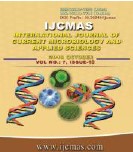


 National Academy of Agricultural Sciences (NAAS)
National Academy of Agricultural Sciences (NAAS)

|
PRINT ISSN : 2319-7692
Online ISSN : 2319-7706 Issues : 12 per year Publisher : Excellent Publishers Email : editorijcmas@gmail.com / submit@ijcmas.com Editor-in-chief: Dr.M.Prakash Index Copernicus ICV 2018: 95.39 NAAS RATING 2020: 5.38 |
A field experiment was conducted at Regional Research Station, Bawal, Haryana during 2015-16 on loamy sand soil under irrigated condition to find out suitable intercrops viz., greengram, groundnut, clusterbean and sesamum under three different row spacings of castor 120, 180 and 240 cm. Results revealed that oil content of castor was not affected by different intercropping systems and row spacing of castor. The mean seed yield of sole castor (120 cm) was 5246 kg ha-1, which was more than rest of the treatments. Results showed that magnitude of reduction in seed yield of castor was more severe with sesamum followed by clusterbean. Significantly highest castor equivalent yield (6037 kg ha-1) was obtained in castor (180 cm) + groundnut (1:4), closely followed by castor (240 cm) + greengram (1:2) intercropping system. Net returns was greater when castor was intercropped with greengram either in 1:6 (Rs. 121455 ha-1) or 1:2 (Rs. 119986 ha-1) row proportion. The benefit: cost ratio was highest with castor (240 cm) + greengram in 1:6 row proportion (1.79) and castor (180 cm) + greengram in 1:2 row proportion (1.75).
 |
 |
 |
 |
 |